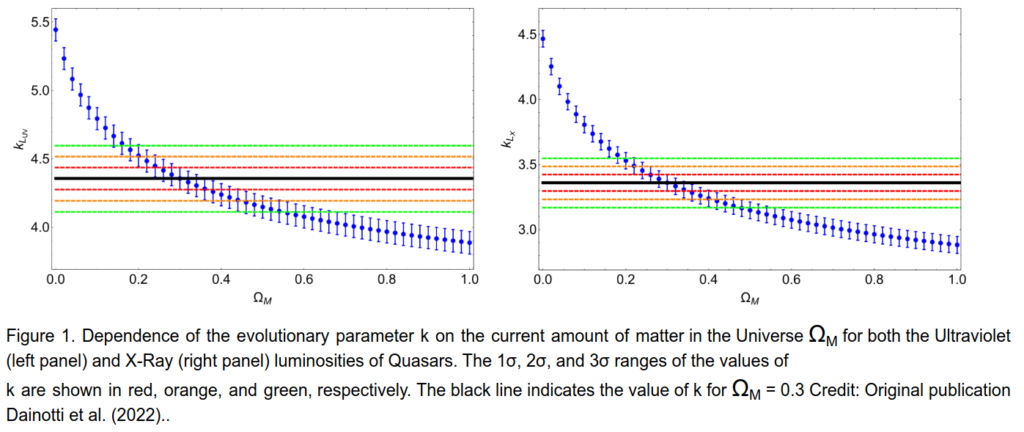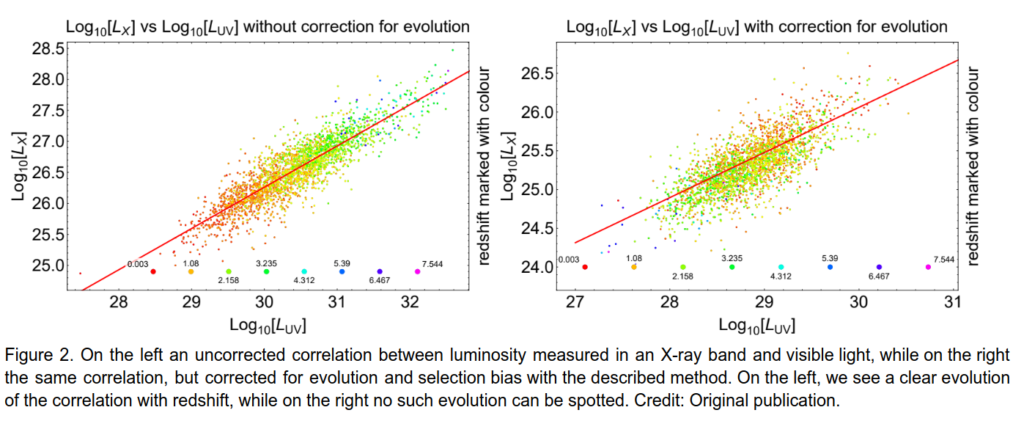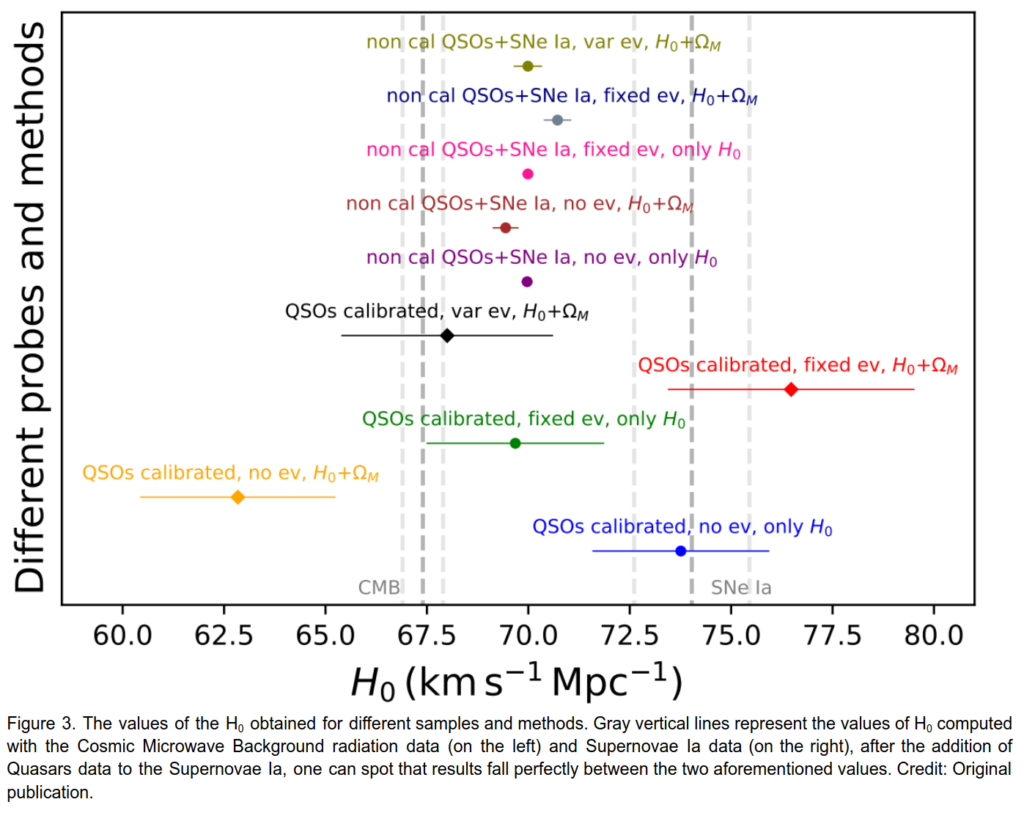Division of Science, NAOJ
Crisis in Cosmology: Statistics on the rescue.
An international team of scientists led by Maria Dainotti from the National Astronomical Observatory of Japan, and her undergraduate student, Aleksander Lenart, from Jagiellonian University with the collaboration of members from Italy (Giada Bargiacchi, as co-lead author in the second paper currently a visiting PhD Student at NAOJ division of Science), Poland, and Japan has released two groundbreaking articles with a solution to one of the biggest challenges of modern observational cosmology. A new statistical method was applied in order to remove the impact of selection biases on cosmological computations while avoiding the so-called circularity problem in cosmology. These articles have been published and accepted for publication in The Astrophysical Journal (Dainotti et al. 2022, Quasar Standardization: Overcoming Selection Biases and Redshift Evolution – NASA/ADS (harvard.edu) and Lenart, Bargiacchi et al. 2023, Astrophysical Journal Supplement Series A bias-free cosmological analysis with quasars alleviating $H_0$ tension – NASA/ADS (harvard.edu)).
Modern cosmology has many open questions: How to solve the discrepancy between the measurements of the Hubble constant? What is the curvature of space-time? What is the nature of dark energy? And many more. Astronomers are trying to shed new light on these issues, by observing the Universe farther and farther away from the Earth. This is driven by the fact that predictions from different cosmological models have minor differences at a low distance. Still, those differences begin to be significant for objects very far away from us.
In order to probe the high-distance Universe, scientists have to use the most luminous objects that ever existed, Quasars and Gamma-Ray Bursts. Quasars are powered by the accretion of gas onto the supermassive black hole in the center of the galaxy. Gamma-Ray Bursts originate when a massive star explodes, or when two neutron stars, or a neutron star and a black hole merge. Since the discovery of these objects, many correlations between their physical quantities have been studied. These correlations allow us to determine the distance of these objects from us. This is crucial for cosmological analyses since we have the theoretical formula for the distance in a given cosmological model, which includes the speed of the expansion of the given point in the Universe. The comparison of the theoretical distance and the observed one allows us to test how well the given cosmological model fits the data.
To this concern, one of the most promising correlation for Quasars is a non-linear relation between the X-Ray and Ultraviolet luminosities of Quasars which has turned into a cosmological tool by Risaliti & Lusso (2019) by significantly reducing its intrinsic dispersion through a selection of the sample.
But looking at high distances has shortcomings: the farther away we look, the most luminous events we see. This phenomenon is called the Malmquist bias effect. This can induce an artificial correlation between the observed parameters, so how do we know if the correlation is a physical feature of the objects, or just induced by a selection effect? This can be tested via a method proposed by Efron & Petrosian (1992) and already successfully developed for quasars by Dainotti et al. 2022. This technique eliminates the correlation between the studied parameters and the observational spectroscopic parameter determining the distance (the redshift).

In this regard, Dainotti et al. 2022 have employed this technique to correct the relation proposed by Risaliti and Lusso for Quasars to check if the uncorrected and corrected correlations present some differences. Remarkably, the authors have shown that the corrected correlation presents the same parameters as the uncorrected one firmly proving that this relation can be safely corrected for selection biases and redshift evolution, and still retains its intrinsic nature to the Quasar physics. This result strongly proves the reliability of this relation to determine Quasar distances to further extend our current knowledge of the Universe at early epochs.

Nevertheless, many correlations involve luminosity and in order to calculate the luminosity, one needs to fix the parameters of the cosmological model. Then, with those fixed values, one determines the correction for the selection bias effect. Consequently, this correction has been applied within the assumed cosmological model. Thus, if we would like to use these corrected values to test some cosmological model, our results will be again biased by the model assumed a priori. This represents the so-called circular problem and it cannot be applied to scientific approaches.
The new articles completely overcome this issue, by creating a new, more general treatment than the one of Efron & Petrosian (1992). This treatment was first discussed by Dainotti et al. (2022), and later has been fully implemented by Lenart & Bargiacchi et. al (2023). While Dainotti et. al (2022) studies how the correction depends on the cosmological parameters, as shown in Figure 1, the method proposed in Lenart & Bargiacchi et. al (2023) is the application of this method to Quasar cosmology without assuming any values of the evolution a priori.
The application of this method to the Risaliti-Lusso correlation for Quasars in Lenart & Bargiacchi et. al (2023) allowed for the first time in the literature to obtain a 2 sigma value of ΩM, the parameter denoting the current amount of matter in the Universe. Moreover, the authors applied the following analysis to study the impact of high-distance measurements on the so-called H0 tension (the incompatibility of the two measurements of the Hubble constant: the one involving Supernovae type Ia and the one obtained from the Microwave Cosmic Radiation). Surprisingly, Quasars seem to prefer the value of the Hubble constant in between the values obtained for Supernovae type Ia and Microwave Cosmic Radiation. This suggests that this discrepancy might be driven by an unknown physics, and not by the statistical effects. The overall results enhance a further significant improvement in cosmological measurements and an extension of our knowledge about the Universe at high distances.

Acknowledgements:
The publications under discussion were made possible, thanks to financial support from the National Astronomical Observatory of Japan (NAOJ), the Astronomical Observatory of Jagiellonian University (UJ) in Cracow, and the Program Council for Mathematical and Natural Sciences Studies at Jagiellonian University. We also acknowledge Scuola Superiore Meridionale of Naples for financially supporting Giada Bargiacchi in her research at NAOJ, Division of Science, and RIKEN for partially funding the second publication. Giada Bargiacchi is grateful to be hosted by the Division of Science at NAOJ where the second paper has been finalized. This research highlight is largely based on the press release from UJ, see the related link aktualia-2023 – Obserwatorium Astronomiczne im. Mikołaja Kopernika – Faculty of Physics, Astronomy and Applied Computer Science (uj.edu.pl)

